|
 Many of the nineteenth century inventors who worked on early motorcycles often moved on to other inventions. Daimler and Roper, for example, both went on to develop automobiles. However, inventors Harley and the Davidsons developed motorcycles and their business competitors were other new start-up companies such as Excelsior, Indian, Pierce, Merkel, Schickel and Thor. Many of the nineteenth century inventors who worked on early motorcycles often moved on to other inventions. Daimler and Roper, for example, both went on to develop automobiles. However, inventors Harley and the Davidsons developed motorcycles and their business competitors were other new start-up companies such as Excelsior, Indian, Pierce, Merkel, Schickel and Thor.
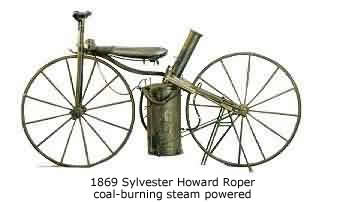
The first really successful production two-wheeler though, was the Hildebrand & Wolfmueller, patented in Munich in 1894. In 1897 a gasoline tricycle built by Louis S. Clarke of Pittsburgh, Pennsylvania. This is a remarkably modern-looking tricycle, converted to self-propulsion by the addition of a single-cylinder gasoline engine mounted just forward of the rear axle.
In 1901, a bicycle racer Oscar Hedstrom designed a motorcycle for the Hendee Manufacturing Company of Springfield, Massachusetts, which later became the Indian Motorcycle Company.
In 1903, 21-year old William S. Harley and 20-year old Arthur Davidson made available to the public the first production Harley-Davidson® motorcycle. The bike was built to be a racer, with a 3-1/8 inch bore and 3-1/2 inch stroke. The factory in which they worked was a 10 x 15-foot wooden shed with the words "Harley-Davidson Motor Company" crudely scrawled on the door. The only American motorcycle manufacturer still in existence from the early days is the Harley-Davidson Motor Company, which celebrated its centennial in 2003.
In 1903, William Harley and his friends Arthur and Walter Davidson launched the Harley-Davidson Motor Company. The bike had a quality engine, so it could prove itself in races, however, the company planned to manufacture it as a transport vehicle. Merchant, C. H. Lange, sold the first officially distributed Harley-Davidson in Chicago.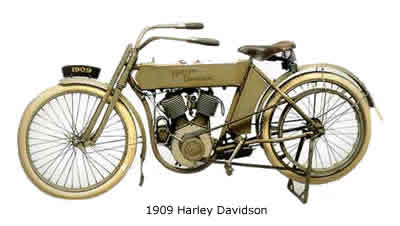
The dream began in 1903 for the Davidson brothers, William D., Walter and Arthur and William S. Harley in a 10’ x 15’ shed located in the Davidson’s families backyard in Milwaukee, Wisconsin. Although they only built three motorcycles that year, it was enough for the Harley-Davidson Motor Company to begin its long journey.
Intoduction of the V-Twin
By 1909, Harley-Davidson had introduced the V-twin, resulting in a more powerful motorcycle and incorporating a new engine that is the company’s standard to this day. This engine had double the power of its predecessors and would go 60 miles an hour, a then-unbelievable feat. By 1911, Harley-Davidson had 150 other brands of motorcycles competing with them on the American roadway.
From Police Work to the Battlefield
Although Harley-Davidson motorcycles were already used for police work, a new use soon appeared. Harley-Davidson motorcycles soon became popular for use on the battlefield. They were the bikes used in the early 1900’s in border skirmishes with Pancho Villa and also to support the infantry in World War 1. By the time the war was over, there had been 20,000 Harley-Davidson’s put into action.
After the war, the motorcycle industry continued on with major advancements in the design of motorcycles with Harley-Davidson leading the way. Harley-Davidson won a race in 1921 thus becoming the first vehicle to win with an average speed of 100 miles per hour. In 1926, the Teardrop gas tank was introduced and in 1928 the front brake came into use.
The Great Depression and Beyond
During The Great Depression, all motorcycle manufacturers except for Harley-Davidson and Indian were devastated. By the year 1941, Harley-Davidson was called upon to build and ship more than 90,000 motorcycles for use during World War II. Harley-Davidson earned the coveted Army-Navy “E” Award for excellence in wartime production.
By 1953, Indian had closed its doors making Harley-Davidson the sole survivor in the American Motorcycle Industry. In 1957, Harley-Davidson introduced the Sportster which ushered in the era of heavy-wight motorcycles.
AVAILABLE MOTORCYCLE ADS BY DATE AND CATEGORY
1900 - 1919 |
1940 - 1949 |
1970 - 1979 |
|
|
|
1920 - 1929 |
1950 - 1959 |
1980 - 1989 |
|
|
|
1930 - 1939 |
1960 - 1969 |
1990 - 1999 |
|
|
|
BSA (Birmingham Small Arms Motorcycle Company)
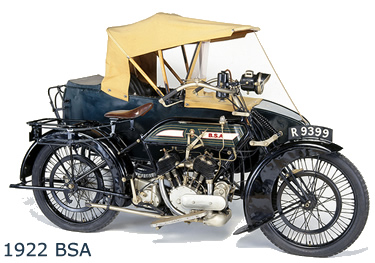
The Birmingham Small Arms (BSA) company produced a lot more than just motorcycles. Planes, taxi’s, guns and much more. Of course motorcycles was a huge part of the companies activities and by 1950’s they were producing more than 75.000 bikes.
BSA started all the way back in 1863 and the bikes division started in 1880. The engine powered bicycle was launched in 1905 with a small Minerva engine attached to it.
BSA had a good reputation for reliable bikes and the success grew with the introduction of the S27 (also known as the sloper model). It was produced for 10 years and was available in a 350cc, 500cc and later a 595cc engine. Through out its production little was change to it’s original popular design.
→ click here for more information on the BSA Company
Harley-Davidson
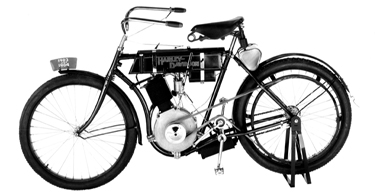
The history of the Harley-Davidson motorcycle began in Milwaukee in 1903. In Milwaukee, Bill Harley and Arthur Walter Davidson developed a one-cylinder motorcycle. Around the turn of the century the gasoline engine was developed and the one-cylinder motor was introduced. In 1901 the Indians were the first motorcycles and in 1903 Mitschell, Merkel and Yale.
This motorcycle was initially built for racing and was powered by a one-cylinder gasoline combustion engine.
→ click here for more information on the Harley-Davidson Company
Indian Motorcycle
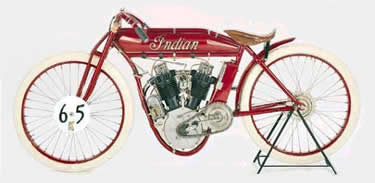
The "Indian Motocycle Co." was founded as the Hendee Manufacturing Company by George M. Hendee and Carl Oscar Hedström. Both Hendee and Hedström were former bicycle racers who teamed up to produce a motorcycle with a 1.75 bhp, single cylinder engine in Hendee's home town of Springfield. The bike was successful and sales increased dramatically during the next decade.
1901, Prototype and two production units successfully designed, built and tested. Work began on these in previous years. 1902, First Indian motorcycles, featuring innovative belt-drives and streamlined styling, sold to public. 1903 Indian co-founder and chief engineer Oscar Hedström sets world motorcycle speed record (56mph).
In 1904, the so-called diamond framed Indian Single, whose engine was built by the Aurora Firm in Illinois, was made available in the deep red color that would become Indian's trademark. By now, the production was up to over 500 bikes annually and would rise to its best ever 32,000 in 1913.
In 1907, Indian built its first V-twin, and in following years made a strong showing in racing and record-breaking. One of the firm's most famous riders was Erwin "Cannonball" Baker, who set many long-distance records. In 1914, he rode an Indian across America, from San Diego to New York, in a record 11 days, 12 hours and ten minutes. Baker's mount in subsequent years was the Powerplus, a side-valve V-Twin, which was introduced in 1916. Its 61ci (1000 cc), 42 degree V-twin engine was more powerful and quieter than previous designs, giving a top speed of 60 mph (96 km/h). The Powerplus was highly successful, both as a roadster and as the basis for racing bikes. It remained in production with few changes until 1924.
Competition success played a big part in Indian's rapid growth and spurred technical innovation, as well. One of the American firm's best early results came in the Isle of Man TT in 1911, when Indian riders Godfrey, Franklin and Moorehouse finished first, second and third. Indian star Jake De Rosier set several speed records both in America and at Brooklands in England, and won an estimated 900 races on dirt and board track racing. He left Indian for Excelsior and died in 1913, aged 33, of injuries sustained in a board track race crash with Charles "Fearless" Balke, who later became Indian's top rider. Work at the Indian factory was stopped while De Rosier's funeral procession passed.
Oscar Hedstrom left Indian in 1913 after disagreements with the Board of Directors regarding dubious practices to inflate the company's stock values. George Hendee resigned in 1916.
→ click here for more information on the Indian Motorcycle Company
Triumph Cycle Company
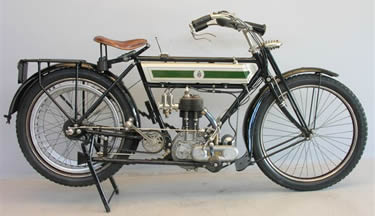
Siegfried Bettmann founded the Triumph Cycle Company in 1887 and promptly acquired premises in Coventry in which he began manufacturing bicycles. As technology advanced the company moved into the production of powered cycles in 1902. By 1905 the factory output had reached 500 motorcycles per year, with the machines being designed, manufactured and built at the Coventry site.
For the next 18 years Triumph enjoyed steady growth and in 1923 the company added automobile production to their portfolio. By 1925 the motorcycle plant in Coventry occupied 500,000-sq. ft. and employed 3000 people; with production at around 25-30,000 units per year.
The motorcycle industry remained fairly stable throughout the early 1930s, and in 1935 the decision was taken to separate the car and motorcycle divisions (the bicycle business had been sold off in 1932). In due course the motorcycle arm was sold and renamed Triumph Engineering Co.
→ click here for more information on the Triumph Motorcycle Company |



